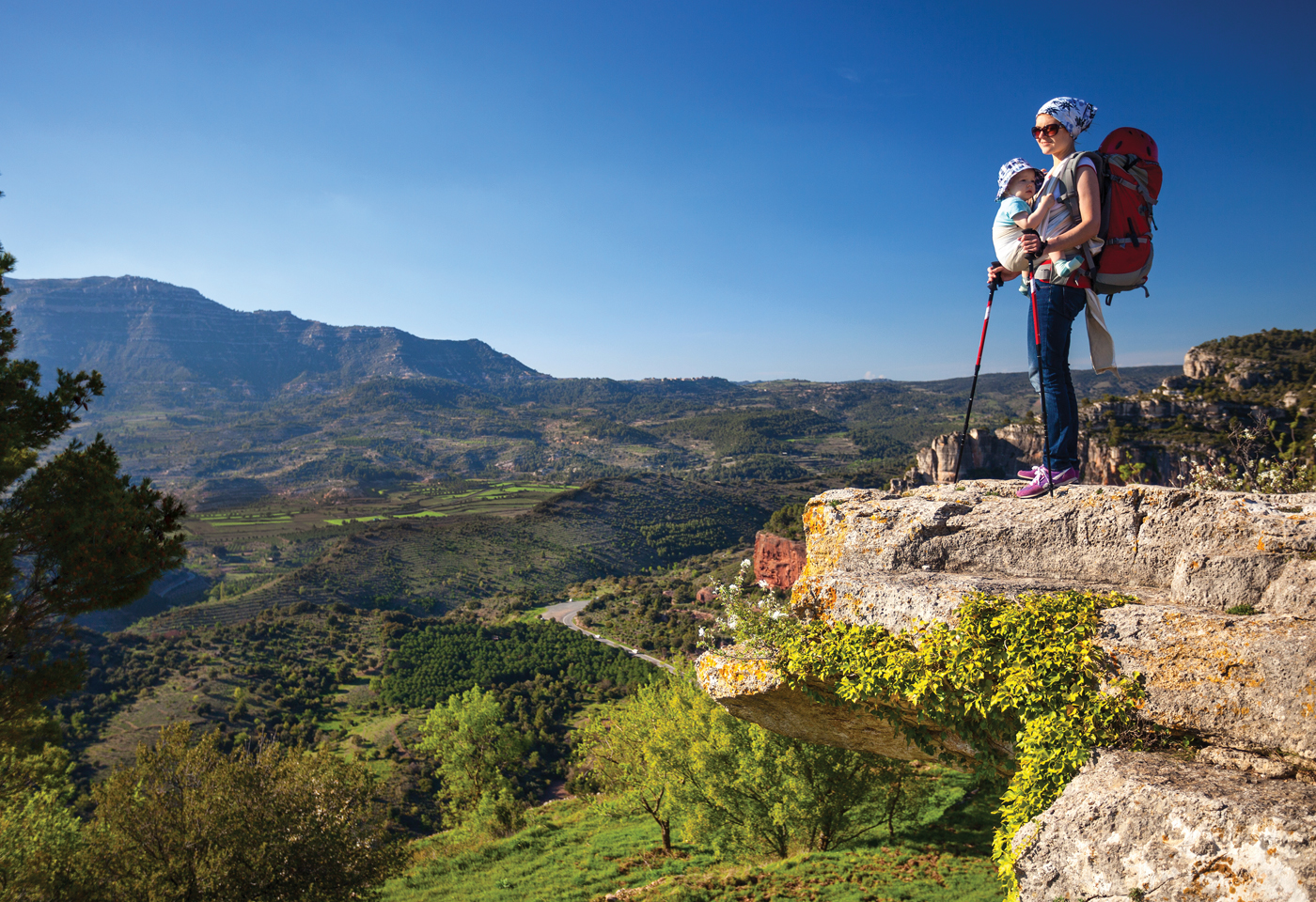The age of adventure

The long-haul flight: 2-3 months old Before my son […]
The long-haul flight: 2-3 months old
Before my son was born, my husband and I had already booked his first trip. We decided to put my maternity leave to good use and take our newbie across the pond to visit family in England. I still remember getting some wide-eyed looks when we shared our plans to take a 2-month-old on an eight-hour flight, but looking back it was the perfect time. We were no longer overwhelmed with the newness of parenthood. Our son had already had his first round of immunizations, and with the exception of a crazy diaper blowout during the boarding process (a story for another time), our trip went off without a hitch. It might sound counterintuitive for your very first trip to be a long voyage, but the newborn stage is the best time to get your feet wet because all baby really needs is you. Honestly, it’s easiest to travel with a brand-new babe because they sleep so much and don’t require a lot of stimulation.
Two to three months is the ideal window for a cross-country or international getaway. Newbies are still in what many call the fourth trimester, which means they’re perfectly content to stay snuggled up in a carrier or be held for hours. The bustle of passengers on a plane is blissful white noise that reminds them of womb life, so they’re likely to snooze right through the majority of your flight.
For the most part, your mini won’t even notice that he’s thousands of feet up in the air. The two caveats: takeoff and landing. Offer a breast, bottle or pacifier to encourage him to swallow, which will help his ears adjust to the pressure change.
At this age, your tot is tiny enough that if you choose to fly with an infant in arms—instead of buying baby his own seat—you can still get comfy. To save your arms from aching, I’d recommend bringing a wrap or sling. That way you can still eat your in-flight meal or read a book while he catches some Z’s. (I wore my son through the airport and right onto the plane. I didn’t even need to pop him out to go through security!)
Because you’ll be stuck in one place for a while, without access to anything other than your carry-ons, what you pack is paramount. Bring more diapers and wipes than you think you’ll need—it’s best to plan for a change every hour of transit. We had only four diaper swaps over the course of our eight-hour journey, but we were covered if there was an unexpected delay or layover. You’ll also want to bring a change of clothes for mom and dad in addition to a few outfits for baby. Our blowout debacle happened before we had even pulled away from the gate, and my husband was grateful (as I’m sure everyone around us was, too) that he could change into a clean T-shirt.
Take it from a mom who’s been there, traveling at this age was infinitely easier than I had imagined it would be. My biggest worry was that my son would cry a lot and disturb other passengers, but he barely made a peep. Plus, now that I’ve been privy to the frequent shrieks of a 7-month-old, I can reassure you that those newborn squawks aren’t as bothersome as you might think they are. They’re actually pretty darn sweet. (If you do have a disgruntled Dan sitting behind you, I have a friend who swears by buying that person a drink. It’s only a few dollars, and the gesture goes a long way.)
Tip for flying with gear: Most airlines accept car seats and strollers as checked baggage for no additional fees. It may be helpful to bring a compact stroller with a quick fold for easy storage. You should also consider investing in a cover or bag to keep each item from getting grimy and to ensure no parts are lost. You do have the option of checking your stroller at the gate, which means you can use it to cart your kid and carry-ons around the airport. The downside is that you’ll need to wait for it on the jetway, which could mean you’ll be at the end of the line for customs and immigration.

The road trip: 5-7 months old
Hitting the road can be a great way for new parents to travel. Not only do you get to set your own pace and schedule, but you also aren’t restricted in what (or how much) you want to pack—well, as long as everything fits in your car.
Before you even pull out of the driveway, you can stack the deck in your favor by making sure baby’s belly is full and giving him ample opportunity to get his wiggles out. Aim to depart right around naptime or bedtime. If he’s tired and full, he’ll snooze through the first leg of (if not most of) your trek. Many babes tend to rest easy in the car, but if sleep isn’t on your little one’s agenda, that’s A-OK. In fact, that brings us to another reason why this stage is well-suited for road-tripping. Around baby’s half-birthday he’ll be more aware of and interested in his surroundings. This means that a cheery song, a teething toy or the passing cars out the window will all be welcome distractions to keep him occupied on the go. (Tip: Go for toys that fasten to the car seat handle or can be attached to a pacifier clip, so they don’t get lost forever in the crevices of your backseat.)
The biggest perk of traveling by car can also quickly become the biggest struggle. You have the freedom to make an unplanned pit stop if someone is feeling fussy. In fact, you can make as many stops as you’d like, but that often means that travel times stretch far beyond the Google Maps estimates. It doesn’t matter if your little one is hungry, needs a change or just desperately wants to cuddle his mama, every single one of those things will require you to pull off the highway, though you could try offering a bottle while he’s buckled in. (Tip: Swap your regular diapers for overnight options en route because the last thing you want to be doing in the rest stop bathroom is scrubbing the car seat.)
Even if your kiddo is happily cruising along, you’ll still want to give him a break to stretch every two hours or so. Use an app like Playground Buddy to find a fun place where you can all burn off some energy; it even lets you know if there is a swing or slide and where to park. Hopefully a diaper change and feeding session during these regularly scheduled reprieves will help cut down on the number of surprise stops, but accept that some are inevitable.
A 6-month-old is also a more vocal backseat buddy, which I was personally happy about because I knew my son was fine if he was babbling and chirping away. When baby is fast asleep, a strategically placed mirror can help you keep a close watch. And, if it makes you feel better (or if your bitty passenger is crying for some company), one of you can always hop in the back to readily comfort or play with your babe. I do this even if we’re just nipping out to the post office on days my little guy seems particularly sensitive.
Should you have a long drive ahead of you, breaking it up over several days could make it more enjoyable for everyone involved. Find a few interesting sights to see on your layovers to keep you from feeling like your vacation won’t start until you reach your final destination. After all, getting there can be half the fun.

The quick getaway: 9-11 months old
Now that your kiddo is on the move, he’s going to want to do just that. So, it will be harder to keep him contained in a car seat—or airplane seat—for long periods of time. (There’s so much to see!) Minimize the stress of travel by limiting the number of hours you spend in transit. Note: This is not to say that you are doomed if you have an international flight on the calendar, but if you’re looking for the path of least resistance, a shorter jaunt is the way to go at this stage.
Although babes at this age are more mobile and energetic, they’re also easily entertained. Their attention spans are minuscule, though, so your best bet will be lots of small distractions to pass the time. Finger-foods make for the best snacks because they require more attention and eat up more time—pun intended.
Some mamas pack several new toys (think things you can find in the Target dollar section) to pull out every hour or so. Tip: Wrap them like presents to add to the excitement and—let’s be real—take up even more time. I know other moms who tout the wonder of gel clings if you happen to be in a window seat. My son has been mesmerized by a straw wrapper for a full 15 minutes, so it really doesn’t take much.
While I have some cherished memories of walking around London with my little boy tucked in close to my chest, the wonderful thing about traveling with an older babe is that they get to be part of it all instead of just tagging along. Watching your little one experience something for the first time, like the ocean lapping the shoreline, will make your heart swell.
Stay what? Rentals through sites like Airbnb, Homeaway and Kid and Coe (a family-friendly option!) give parents perks like a washer and dryer and the added benefit of being able to put baby to bed in another room—so you don’t have to watch TV with the volume all the way down.
Consider these three baby items you’ll want to invite on your expedition:







